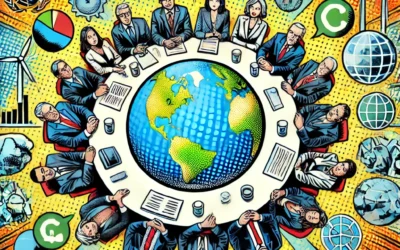Material Consumption: How It Affects the Climate and What We Can Do About It
Material consumption is the amount of natural resources that humans use for various purposes, such as production, consumptionand disposal. It reflects the environmental impact of human activities, as it affects the availability and quality of the resources, as well as the emissions and waste generated by their extraction, processingand use.
According to the OECD Material Consumption Indicator, the average material consumption per capita in the OECD countries was 13.4 tonnes in 2019, with a wide variation across countries. In this article, we will explore how material consumption affects the climateand what we can do to reduce it.
How Material Consumption Affects the Climate
Material consumption affects the climate in several ways, depending on the type, amountand context of the use of the resources. Some of the main effects are:
Greenhouse gas emissions: Material consumption is a major source of greenhouse gas emissions, which cause global warming and climate change. The extraction, processingand use of fossil fuels, such as coal, oiland gas, emit carbon dioxide and other gases that trap heat in the atmosphere. The extraction, processingand use of other materials, such as metals, mineralsand biomass, also emit greenhouse gases, either directly or indirectly, through land use change, deforestationand transportation. According to the Global Material Resources Outlook to 2060, material consumption could account for 60% of global greenhouse gas emissions by 2060, if no action is taken to reduce it.
Resource depletion and degradation: Material consumption can also deplete and degrade the natural resources that are essential for the climate system, such as water, soiland biodiversity. The overuse and misuse of water resources, such as groundwater and surface water, can affect the water cycle and the hydrological balanceand lead to water scarcity, droughtand flooding. The erosion and contamination of soil resources, such as topsoil and organic matter, can affect the soil quality and fertilityand reduce the carbon sequestration and storage capacity of the soil. The loss and fragmentation of biodiversity resources, such as forests and wetlands, can affect the ecosystem functions and services, such as carbon storage, water regulationand climate regulation.
Waste generation and disposal: Material consumption can also generate and dispose of large amounts of waste, which can have negative impacts on the climate. The waste can include solid waste, such as plastic, paperand metal, liquid waste, such as wastewater and runoffand gaseous waste, such as methane and nitrous oxide. The disposal of waste can involve landfilling, incineration, or dumping, which can emit greenhouse gases, leach pollutantsand contaminate the environment. The waste can also accumulate and persist in the environment, such as in the oceans and the atmosphereand affect the climate system and the living organisms.
Sustainable Materials Management
Addressing the challenges posed by Material Consumption requires a shift towards Sustainable Materials Management (SMM). SMM emphasizes the efficient use of resources and minimizing environmental impact.
Strategies for Reduction
To mitigate the effects of Material Consumption, we can:
- Opt for renewable and recyclable materials.
- Implement efficient manufacturing processes.
- Encourage consumer behavior towards sustainable products.
Conclusion
Material consumption is the amount of natural resources that humans use for various purposes, such as production, consumptionand disposal. It affects the climate in several ways, such as greenhouse gas emissions, resource depletion and degradationand waste generation and disposal.
Material consumption can be reduced by adopting and promoting the principles and practices of the circular economy, such as reduce, reuseand recycle. Material consumption is a key indicator of the human-environment relationshipand can contribute to the goals and targets of climate policy and sustainable development.






